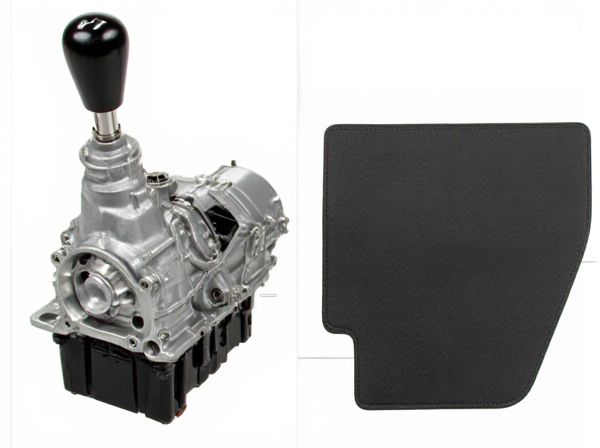
Photo illustration: Column shifter vs Floor shifter
A column shifter is mounted on the steering column, saving space between seats and offering a traditional, easy-to-reach gear change. Floor shifters are positioned on the car's center console, providing a sportier feel and often better tactile feedback for more precise gear shifts. Your choice depends on preferences for interior space, driving style, and ergonomic comfort.
Table of Comparison
| Feature | Column Shifter | Floor Shifter |
|---|---|---|
| Location | Mounted on steering column | Located on vehicle floor between seats |
| Space Utilization | Frees up center console space | Occupies center console area |
| Ease of Access | Easy to reach without moving hands far | Requires hand movement from steering wheel |
| Common Usage | Older vehicles, trucks, some SUVs | Sports cars, manual transmissions, modern vehicles |
| Shifting Precision | Less precise, longer lever movement | More precise, shorter lever throw |
| Driver Control | Standard control, less sporty feel | Enhanced control, preferred for performance |
| Maintenance | Generally lower maintenance | May require more frequent adjustments |
Introduction to Column Shifter vs Floor Shifter
Column shifters are mounted on the steering column, providing easy reach and allowing more floor space, making them common in older vehicles and trucks. Floor shifters, positioned on the center console or floor, offer precise gear changes and a sportier feel favored in performance and modern cars. Both types impact driving ergonomics, interior layout, and vehicle control dynamics.
Historical Evolution of Shifter Types
Column shifters dominated early automotive design due to their space-saving placement on the steering column, emerging prominently in the 1930s to accommodate bench seats and enhance interior room. Floor shifters gained traction in the mid-20th century, especially in performance and sports cars, offering more precise gear engagement and a sportier driving experience. Over time, advancements in transmission technology and ergonomic preferences influenced the shift from column-mounted mechanisms to more driver-centric floor shifters in many vehicle segments.
Design and Placement Differences
Column shifters are mounted on the steering column, offering a compact design that maximizes floor space and enhances cabin openness. Floor shifters are positioned on the center console, providing a sportier feel and easier access for precise gear changes in performance driving. The choice between these designs impacts ergonomics and interior layout, influencing driver engagement and comfort.
Driving Experience and Ergonomics
Column shifters offer more cabin space and allow for easier reach without major hand movement, enhancing comfort during city driving and stop-and-go traffic. Floor shifters provide a more tactile and precise shifting feel, often preferred in performance vehicles for enhanced control and quicker gear changes. Ergonomically, floor shifters promote a natural arm position and engagement, while column shifters favor convenience and ease of use in larger vehicles.
Performance and Shifting Precision
Floor shifters generally offer superior shifting precision and quicker gear changes due to their shorter linkage and more direct mechanical connection to the transmission. Column shifters often experience more play and less responsiveness because of longer linkage paths and additional joints, which can reduce shifting accuracy. Enthusiasts seeking high-performance driving typically prefer floor shifters for their enhanced tactile feedback and faster gear engagement.
Interior Space and Vehicle Layout
Column shifters free up interior space by relocating the gear selector to the steering column, allowing for a cleaner center console design and increased legroom. Floor shifters occupy the central console area, which can limit storage options and reduce passenger space, especially in compact vehicles. Vehicle layouts with column shifters often optimize cabin ergonomics, enhancing accessibility and comfort for both driver and front-seat passengers.
Aesthetic Appeal and Customization Options
Column shifters offer a classic, minimalist look that complements vintage and retro vehicle interiors, while floor shifters provide a sporty and aggressive aesthetic favored in performance and muscle cars. Floor shifters allow more extensive customization through various handles, materials, and finishes, enabling drivers to personalize their cockpit's style and ergonomics. Column shifters typically have limited design variations, focusing more on functional simplicity than on visual impact or customization flexibility.
Maintenance and Reliability Factors
Column shifters generally offer easier access to internal components, making repairs and maintenance less time-consuming, while floor shifters often require removal of console parts, increasing service complexity. Reliability factors favor column shifters due to simpler mechanical linkages and fewer exposed parts prone to wear, whereas floor shifters, with direct linkage mechanisms, can provide more precise control but may suffer from faster wear in high-performance settings. Maintenance costs tend to be lower for column shifters because of their straightforward design, but enthusiasts may prefer floor shifters for enhanced driving feedback despite potentially higher upkeep demands.
Suitability for Various Vehicle Types
Floor shifters are better suited for sporty and performance vehicles due to their ergonomic placement that allows quicker gear changes and enhanced driving control. Column shifters are commonly found in trucks, SUVs, and older cars, offering more cabin space and ease of use, especially for vehicles prioritizing comfort and practicality. The choice between column and floor shifters depends largely on the vehicle's design goals and intended driver experience.
Pros and Cons: Column Shifter vs Floor Shifter
Column shifters offer increased cabin space and easier access, making them ideal for trucks and older vehicles, but they can feel less precise due to longer linkages. Floor shifters provide quicker, more accurate gear changes and a sportier driving experience, favored in performance cars, though they may consume valuable center console space. Choosing between column shifter vs floor shifter depends on preference for interior layout versus shifting responsiveness.
 caratoz.com
caratoz.com